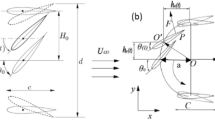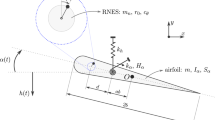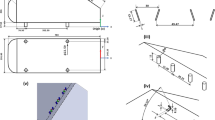Abstract
Although the streamline box girder exhibits an excellent aerodynamic performance, they are often suffer severe Vortex-Induced Vibrations (VIVs) due to complicated separation and reattachment of air flows. It is necessary to apply control measures on the streamline box girder to suppress VIV. In this study, the VIV optimizations of a super wide streamline box girder were conducted via a series of section model wind tunnel tests. The effects of wind fairings, inspection vehicle rails, guide vanes, traffic barriers and handrails on the heaving VIV performance of the wide streamline box girder were analyzed. The test results show that the inspection vehicle rail and handrail are the main members to induce the heaving VIV of the box girder. A sharper wind fairing without changing the distance of railings is favorable to the heaving VIV performance. However, the countermeasures of changing the position of inspection vehicle rail and installing guide vanes under the girder have slight influences on reducing heaving VIV responses. Inspired by the spanwise sinusoidal perturbation method, the traffic barriers sealed with plates by regular intervals along the bridge deck can suppress the heaving VIV of the box girder successfully. The porosity of handrails has a significant effect on the heaving VIV. By using a sharp wind fairing and circular simplified handrails, the VIV performance of the wide streamline box girder was greatly improved. Their mitigation abilities were verified by a large-scale section model wind tunnel test.
Similar content being viewed by others
References
Battista, R. C. and Pfeil, M. S. (2000). “Reduction of vortex-induced oscillations of Rio-Niterói bridge by dynamic control devices.” Journal of Wind Engineering & Industrial Aerodynamics, Vol. 84, No. 3, pp. 273–288, DOI: 10.1016/S0167-6105(99)00108-7.
Bearman, P. and Brankovic, M. (2004). “Experimental studies of passive control of vortex-induced vibration.” European Journal of Mechanics-B/Fluids, Vol. 23, No. 1, pp. 9–15, DOI: 10.1016/j.euromechflu.2003.06.002.
China’s Ministry of Transportation (2004). Wind-resistant design specification for highway bridges, Report No. JTG/TD60-01-2004, China Communications Press, Beijing, China (in Chinese).
El-Gammal, M., Hangan, H., and King, P. (2007). “Control of vortex shedding-induced effects in a section bridge model by spanwise perturbation method.” Journal of Wind Engineering & Industrial Aerodynamics, Vol. 95, No. 8, pp. 663–678, DOI: 10.1016/j.jweia.2007.01.006.
Fujino, Y. and Yoshida, Y. (2002). “Wind-induced vibration and control of Trans-Tokyo Bay crossing bridge.” Journal of Structural Engineering, Vol. 128, No. 8, pp. 1012–1025, DOI: 10.1061/(ASCE)0733-9445(2002)128:8(1012).
Frandsen, J. B. (2001). “Simultaneous pressures and accelerations measured full-scale on the Great Belt East suspension bridge.” Journal of Wind Engineering & Industrial Aerodynamics, Vol. 89, No. 1, pp. 95–129, DOI: 10.1016/S0167-6105(00)00059-3.
Ge, Y. J., Yang, Y. X., and Cao, F. C. (2011). “VIV sectional model testing and field measurement of Xihoumen Suspension Bridge with twin box girder.” Proceeding of 13th International Conference on Wind Engineering, Amsterdam, Netherlands, July 11–15.
Highway Agency of England (2001). Design manual for roads and bridges (Part 3) Design rules for aerodynamic effects on bridges. Report No. BD 49/01, Highway Agency of England, UK.
Laima, S. J., Li, H., Chen, W. L., and Ou, J. P. (2018). “Effects of attachments on aerodynamic characteristics and vortex-induced vibration of twinbox girder.” Journal of Fluids and Structures, Vol. 77, pp. 115–133, DOI: 10.1016/j.jfluidstructs.2017.12.005.
Larsen, A., Esdahl, S., Andersen, J. E., and Vejrum, T. (2000). “Storebælt suspension bridge-vortex shedding excitation and mitigation by guide vanes.” Journal of Wind Engineering & Industrial Aerodynamics, Vol. 88, No. 2, pp. 283–296, DOI: 10.1016/S0167-6105(00)00054-4.
Larsen, A., Savage, M., Lafrenière, A., Lafrenière, A., Hui, M. C. H., and Larsen, S. V. (2008). “Investigation of vortex response of a twin box bridge section at high and low Reynolds numbers.” Journal of Wind Engineering & Industrial Aerodynamics, Vol. 96, No. 6, pp. 934–944, DOI: 10.1016/j.jweia.2007.06.020.
Larsen, A. and Wall, A. (2012). “Shaping of bridge box girders to avoid vortex shedding response.” Journal of Wind Engineering & Industrial Aerodynamics, Vol. 104, No. 3, pp. 159–165, DOI: 10.1016/j.jweia.2012.04.018.
Li, H., Laima, S. J., Zhang, Q. Q., Li, N., and Liu Z. Q. (2014). “Field monitoring and validation of vortex-induced vibrations of a longspan suspension bridge.” Journal of Wind Engineering & Industrial Aerodynamics, Vol. 124, No. 7, pp. 54–67, DOI: 10.1016/j.jweia.2013.11.006.
Matsumoto, M., Shiraishi, N., Shirato, H., Stoyanoff, S., and Yagi, T. (1993). “Mechanism of, and turbulence effect on vortex-induced oscillations for bridge box girders.” Journal of Wind Engineering & Industrial Aerodynamics, Vol. 49, Nos. 1–3, pp. 467–476, DOI: 10.1016/0167-6105(93)90041-L.
Meng, X. L., Guo, Z. S., Ding, Q. S., and Zhu, L. D. (2011). “Influence of wind fairing angle on vortex-induced vibrations and flutter performances of closed and semi-closed box decks.” Engineering Mechanics, Vol. 28, No. S1, pp. 184–188 (in Chinese).
Nagao, F., Utsunomiya, H., Yoshioka, E., Ikeuchi, A., and Kobayashi, H. (1997). “Effects of handrails on separated shear flow and vortex-induced oscillation.” Journal of Wind Engineering & Industrial Aerodynamics, Vols. 69–71, pp. 819–827, DOI: 10.1016/S0167-6105(97)00208-0.
Owen, J. C., Bearman, P. W., and Szewczyk, A. A. (2001). “Passive control of VIV with drag reduction.” Journal of Fluids and Structures, Vol. 15, Nos. 3–4, pp. 597–605, DOI: 10.1006/jfls.2000.0358.
Qian, G. W., Cao, C. F., and Ge, Y. J. (2015). “Vortex-induced vibration performance of cable-stayed bridge with Π shaped composite deck and its aerodynamic control measures.” Journal of Vibration and Shock, Vol. 34, No. 2, pp. 176–181 (in Chinese), DOI: 10.13465/j.cnki.jvs.2015.02.031.
Sun, Y. G., Li, M. S., and Liao, H. L. (2013). “Investigation on vortex-induced vibration of a suspension bridge using section and full aeroelastic wind tunnel tests.” Wind and Structures, Vol. 17, No. 6, pp. 565–587, DOI: 10.12989/was.2013.17.6.565.
Sun, Y. G., Liao, H. L., and Li, M. S. (2012). “Mitigation measures of vortex-induced vibration of suspension bridge based on section model test.” Journal of Southwest Jiaotong University, Vol. 47, No. 2, pp. 218–223 (in Chinese), DOI: 10.3969/j.issn.0258-2724.2012.02.008.
Xu, F. Y., Ying, X., Li, Y. N., and Zhang, M. J. (2016). “Experimental explorations of the torsional vortex-induced vibrations of a bridge deck.” Journal of Bridge Engineering, Vol. 21, No. 12, pp. 04016093, DOI: 10.1061/(ASCE)BE.1943-5592.0000941.
Yang, Y. X., Ma, T., and Ge, Y. J. (2015). “Evaluation on bridge dynamic properties and VIV performance based on wind tunnel test and field measurement.” Wind and Structures, Vol. 20, No. 6, pp. 719–737, DOI: 10.12989/was.2015.20.6.719.
Yang, Y. X., Zhou, R., and Ge, Y. J. (2014). “Vortex-induced vibration and its control for long span bridges with twin box girder.” China Civil Engineering Journal, Vol. 44, No. 12, pp. 107–114 (in Chinese), DOI: 10.15951/j.tmgcxb.2014.12.013.
Yang, Y. X., Zhou, R., Ge, Y. J., and Zhang, L. H. (2016). “Experimental studies on VIV performance and countermeasures for twin-box girder bridges with various slot width ratios.” Journal of Fluids and Structures, Vol. 66, pp. 476–489, DOI: 10.1016/j.jfluidstructs.2016.08.010.
Zhang, W., Wei, Z. G., Yang, Y. X., and Ge, Y. J. (2008). “Comparison and analysis of vortex induced vibration for twin-box bridge sections based on experiments in different Reynolds numbers.” Journal of Tongji University (Natural Science), Vol. 36, No. 1, pp. 6–11 (in Chinese).
Zhu, L. D. (2005). “Mass simulation and amplitude conversion of bridge section model test for vortex-excited resonance.” Engineering Mechanics, Vol. 22, No. 5, pp. 204–208 (in Chinese).
Author information
Authors and Affiliations
Corresponding author
Rights and permissions
About this article
Cite this article
Li, M., Sun, Y., Jing, H. et al. Vortex-Induced Vibration Optimization of a Wide Streamline Box Girder by Wind Tunnel Test. KSCE J Civ Eng 22, 5143–5153 (2018). https://doi.org/10.1007/s12205-018-0548-y
Received:
Revised:
Accepted:
Published:
Issue Date:
DOI: https://doi.org/10.1007/s12205-018-0548-y




